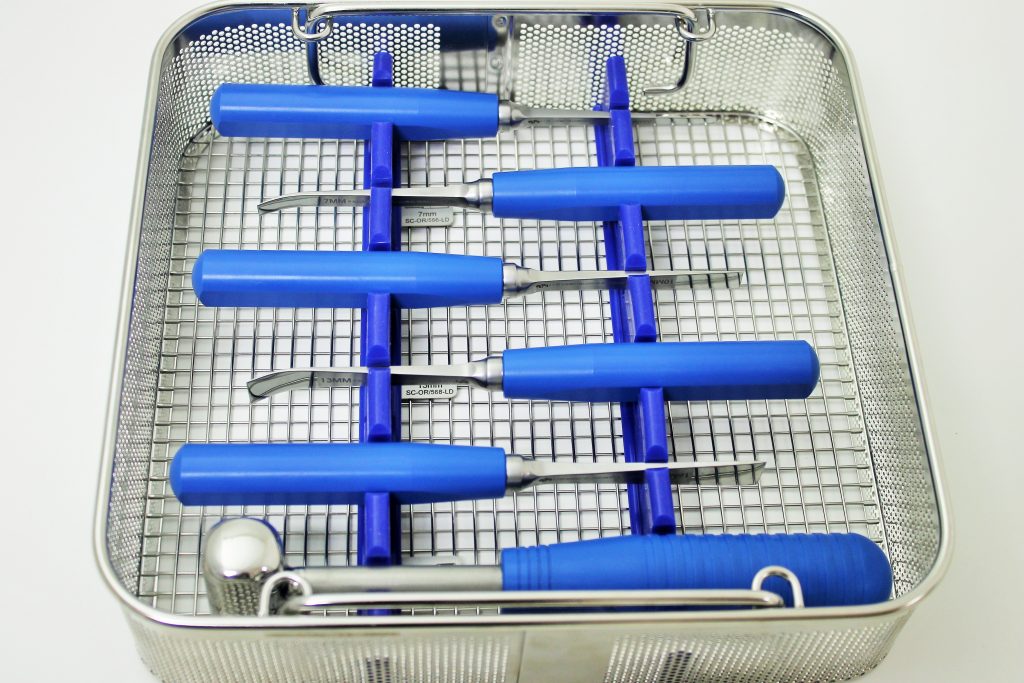in General, Industry, Medtech News
Optimising Instrument Cleaning
I recently read an article in Zentral Sterilisation which carried recommendations for optimising medical device positioning in sterilising trays and DIN baskets when washing medical devices in AWDs, which resonates strongly when looking to ensure medical device longevity and device cleanliness.
Modern AWDs have a spray system that is responsible for water and chemical distribution. This is to ensure that all items being cleaned are in contact with/indirect contact with the cleaning solution. The main issues are highlighted as the design of the spray system, water supply including pressure, what baskets are being used, including their geometry and are there supports used for holding the instruments. Finally, are the instrument positioned appropriately to avoid things such as shadowing?
Regular checking and maintenance on the AWD for the mechanical workings of the washer arms are key, to ensure there are no missed areas (described as spray shadowing). It is very important nozzles are not blocked, which cause incorrect spray angles, thus possibly risking that instruments may not be thoroughly cleaned.
In the UK, previous years have seen hospitals require bespoke din basket setups, generally for more delicate instruments (as below), however, this is more to ensure the surgical instruments are not damaged when being reprocessed. Although this is of course a benefit of this type of tray organisation, the real importance should, of course, be patient safety, therefore ensuring the best cleaning efficacy possible in the tray:
The baskets used themselves are generally wire mesh, which ensures the best water flow through the baskets, however, this alone is not enough to ensure thorough cleanliness and additional silicone inserts may be required.
Zentral Sterilisation stated that in all cases it must be ensured that surgical instruments are positioned in the baskets so that they can be accessed by spray and washer arms from all sides and this, of course, will ensure all chemicals are rinsed and no residues remain and ultimately the device is cleaned properly. The article stated that the use of silicone pimple type matting alone wasn’t suitable, as this can cause pooling in the basket, attributing to wet loads. However, strips of silicone type material and supportive bars can be used to position devices and ensure that devices are positioned, so they can be accessed.
The basket below is bespoke for an orthopaedic screwdriver set and ensures that each device has its own fixation and this includes the screw set. All items are disassembled. the silicone allows for comfortable holding of the device, without putting stress on them and as the devices are spaced out in adequate gaps, improved cleaning efficacy is achieved.
If trays have to be revalidated, it may be worth establishing a set protocol for holding different devices. i.e. for holding artery forceps, which may need to be held at 90 degrees, so the box joint can be accessed.
The Zentral Sterilisation points out that the complexity of medical devices and range of devices available continues to grow; surely also the way these devices are held should also be progressed. At present, we see sets of 200 instruments thrown on top of each other in a basket together, with sometimes only a mayo instrument pin to distinguish between instruments. Expensive fibre light leads have to be wrapped around the tray, which inevitably leads to damage to the device and certainly not the best chance of cleaning the instruments correctly. For this culture to change, the solutions need to be in place and for CSSD staff to know what is possible and available to them, only this way can the manufacturers assist to contribute to the safest possible outcome for the patient.
The basket set up below shows how a range of implants could be organised, utilising the space in the basket and ensuring space between the medical devices.
Scopes can also be accommodated to ensure delicate flexible parts are neatly coiled and held in place with the silicone inserts.
For organisational purposes, it is also possible to add a drawing to the side of baskets so staff can quickly see how they should be organising the devices when reprocessing the device.
Baskets can be layered and designed with the input of CSSD staff, to ensure that complex orthopaedic sets, for example, are loaded all into one tray which will not cause other issues such as torn wrap
It will be interesting to see the evolution of the organisation of medical devices for reprocessing and optimising surgical instrument cleaning. it is obvious that they should be laid out so each device receives the same amount of spray. Conventional dishwasher works well, as they have specific compartments predesigned into their racking for knives/forks/glasses/bowls/plates; however, the challenges with medical devices are almost infinite and there are no set sizes of basket or of course instrument. Cost is also, of course, a limitation, but with Prion issues currently present in the news, regarding Dementia in the UK (http://www.nhs.uk/news/2015/09September/Pages/Alzheimers-seeds-found-in-seven-CJD-victims-brains.aspx), surely we should be acting now to ensure for patient safety, devices are washed effectively and safely and of course for medical device longevity and unnecessary damage.
If you have a requirement for Bespoke Medical Device Fixation, including bespoke DIN basket solutions then please contact Surgical Holdings via email at info@surgicalholdings.co.uk. Or you can visit our Smart Instrument Repair page and instrument refurbishment page.
